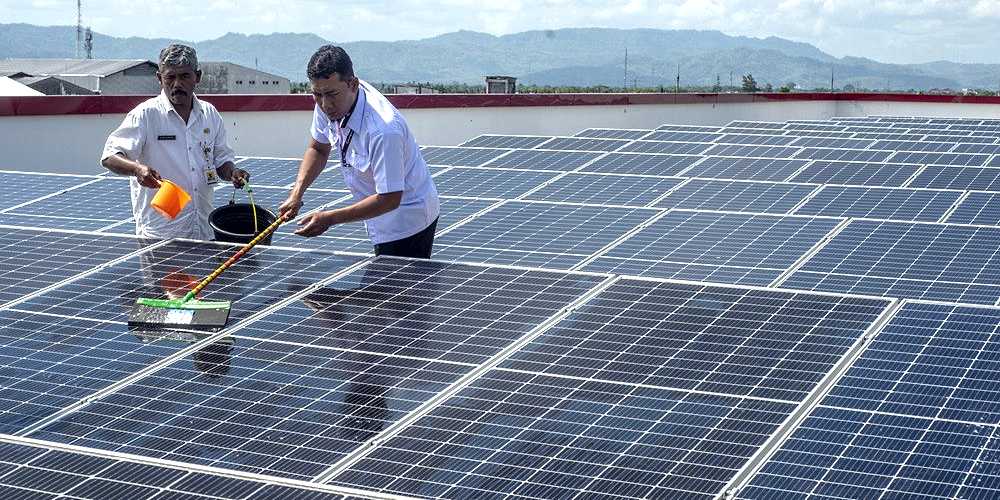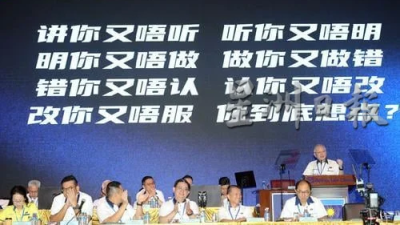
JAKARTA: Indonesia, like most other countries, has committed to cutting carbon emissions by relying less on coal and more on renewable sources of energy, but the past year has revealed serious challenges to this effort.
The installed capacity for new and renewable energy (NRE) reached 12.5 percent of the total electricity generation capacity in mid-2023, according to the Energy and Mineral Resources Ministry, still far below the 17.9 percent target set for this year.
The figure is a minuscule increase from 12.2 percent in 2021 and 12.3 percent in 2022.
Indonesia Centre for Renewable Energy Studies (ICRES) chairman Surya Darma said the expansion in the country’s NRE capacity lagged the increase in electricity generation capacity of coal-fired power plants.
“A more serious and consistent effort from the government is critical, including by providing incentives to push [clean power use] in the country,” he told The Jakarta Post on Dec. 21.
The ministry’s projections for the year showed that NRE energy capacity nationwide would grow by 115 megawatts (MW), not even a third of the 368 MW targeted.
In contrast, coal-fired power plants reached electricity generation capacity amounting to 530 MW by mid-year.
According to the Institute for Essential Services and Reform (IESR), such numbers indicate stagnancy in the decarbonisation of the power sector, putting the country at risk of missing its peak emissions target.
The government is also trying to boost the adoption of rooftop solar panels toward a targeted capacity of 2.14 GW by 2030, but the initiative has fallen far short of its target, achieving only 95 MW, or a mere 4.4 percent of the targeted capacity, as of May 2023.
Ahmad Zuhdi Dwi Kusuma, an industry and area analyst at state-owned Bank Mandiri, said that in many cases, several factors made generating electricity from renewable sources more expensive than from fossil fuels.
These included too great a distance between renewable power plants and demand centres, which called for massive investments in grid development, as well as the issue of intermittency or a fluctuating power supply, which required energy storage systems to resolve.
Read also: RI renewable energy investment lowest in years amid transition push
“If electricity from renewables was cheap, the demand and the potential economy of scale would be larger. But if electricity from coal plants is cheaper, why would [consumers] use electricity from renewable sources?” Ahmad told the Post on Dec. 21.
He added that strong political will was necessary to redirect coal subsidies to renewables.
High tariffs
PLN Energi Primer Indonesia (PLN EPI), a subsidiary of state-owned electricity company PLN, said the electricity supply costs (BPP) for renewable energy remained relatively high to date, Kontan reported on Dec. 17.
Citing 2018-2022 data from its parent company, PLN EPI operations director Eko Yuniarto explained that at an average BPP of Rp430 per kilowatt-hour (kWh), hydropower was the cheapest form of renewable energy.
Geothermal and solar power, on the other hand, had respective BPPs of Rp975 per kWh and Rp4,712 per kWh, according to Eko.
He also noted, however, that the cost of renewable energy continued to decrease with each passing year. For instance, the cost of generating solar power was Rp11,817 just three years ago in 2020.
Still, solar power was still uncompetitive in terms of BPP when compared to coal, which averaged Rp705 per kWh in 2018-2022, he said.
“In general, new and renewable power generation is not cheap. This is a challenge. Renewables need incentivising because [their] BPP is still not affordable for people […],” Eko told a webinar on Dec. 15, Kontan reported.
Rajat Agarwal, partner and leader of energy and materials practice in Southeast Asia at consultancy McKinsey & Company, stressed however that solutions to increase the competitiveness of renewable energy had to be balanced in terms of disincentivising coal versus lowering renewable energy costs.
“I think the costs of renewables materials are constantly decreasing, and what we need is the scale, the infrastructure and the local demand,” Karambir Anand, a Jakarta-based partner at McKinsey & Company, told the Post on Nov. 21.
Missing 2025 target
The energy ministry has confirmed that Indonesia will not fulfil it 23 percent renewable energy mix target by 2025, as most of the planned renewable energy projects will only start generating power in 2026 or later, according to their commercial operation dates (CODs).
Renewables director general Yudo Dwinanda Priaadi said the ministry projected that the country would achieve an additional 1.52 GW from renewable energy in 2025, far below the 5.54 GW target set for that year.
“In terms of projections and realisation until 2025, the target will not be achieved,” Yudo told a meeting on Nov. 15 with House of Representatives Commission VII, which oversees energy and mineral resources.
Continuing, he projected that installed NRE capacity would grow by 5.55 GW in 2026 and then by 3.04 GW in 2027, adding that the ministry would ensure that the CODs for renewable energy projects would be met, while floating hydroelectric and solar photovoltaic projects would be expedited.
He also stressed that, aside from local content requirements, financing remained a key obstacle to renewable energy projects.
JETP funding?
The fact that grants make up only 1.4 percent of the funding pledged for Indonesia’s Just Energy Transition Partnership (JETP) has dampened hopes that the world’s largest energy financing package will spearhead the nation’s energy transition efforts.
Grants comprise only US$300 million of the $21.5 billion committed to the JETP, with the rest coming from loans and equity financing.
Wahyudi Askar Media, public policy director at the Centre of Economic and Law Studies (CELIOS), said the minimal share of grants in the JETP could impose a significant financial burden on organisations and state-owned enterprises (SOEs) involved in energy transition projects.
“Loan repayment obligations actually delay the energy transition’ progress, because they limit the ability to adapt to changing situations,” he said on Nov. 8, as quoted by Kompas.
After it was unveiled in 2022, Indonesia had been banking on the JETP,to help fund the early retirement of its coal-fired power plants, which have a combined capacity of 16.8 GW.
However, the draft investment plan published last month revealed that only around $1.5 billion of JETP funding was designated for phasing out coal in the country.
As a result, the government presented a less ambitious plan to retire its coal power plants.
ADVERTISEMENT
ADVERTISEMENT








































